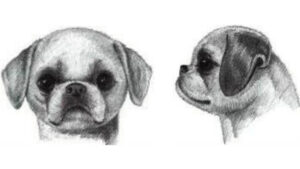
The Shih Tzu Head
Explore the Shih Tzu head’s history and standards, a breed trait facing loss, as described in a seminal 1972 article. Preservation is key.
Home » Dog Breeds » Shih Tzu Dog Breed
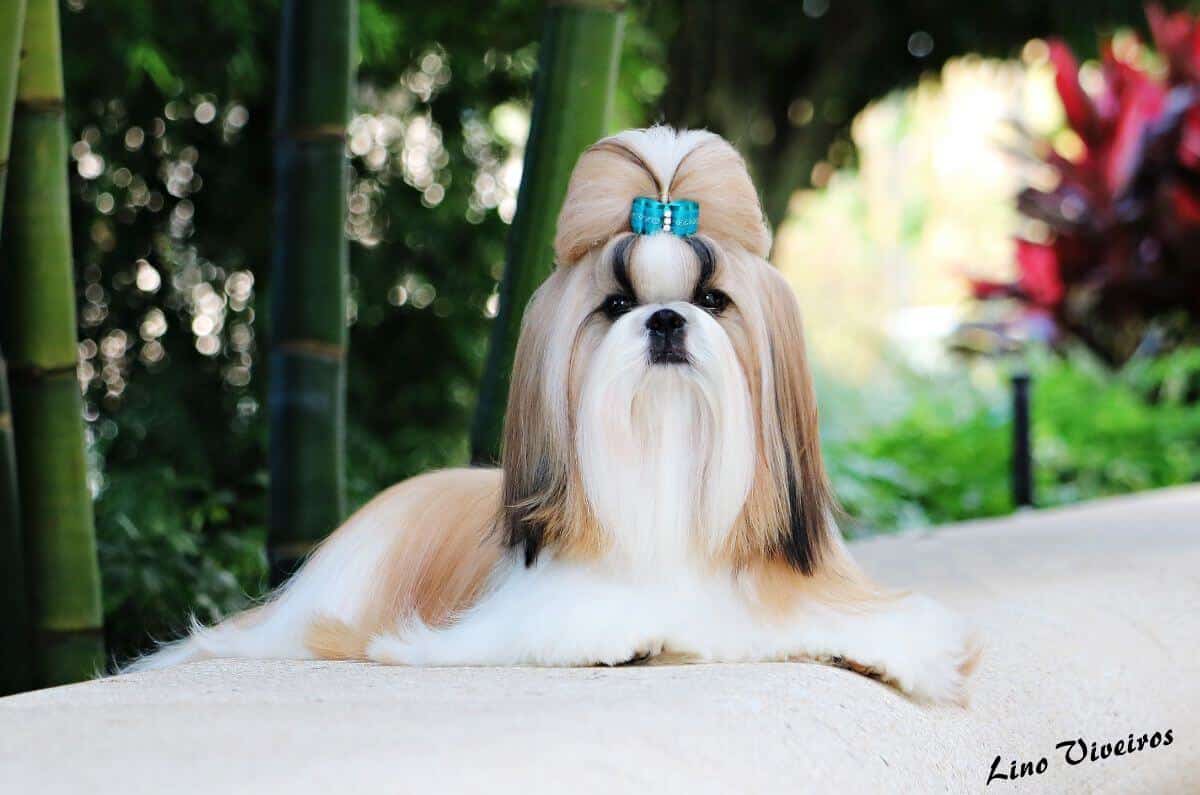
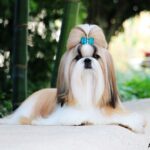
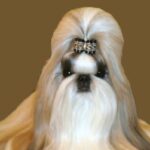
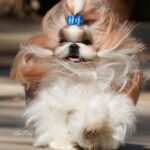
The Shih Tzu, known originally as the “Lion Dog” in Chinese royal circles, is an ancient breed that epitomizes a curious combination of affection and arrogance. This lively little dog, with its luxurious coat and colorful character, is renowned for its warm, expressive eyes and friendly, outgoing personality. A colorful canine companion in a small yet sturdy package, the Shih Tzu has long been a popular choice in households where the breed’s considerable charms are appreciated and allowed to flourish.
Toy
9 – 10.5 inches
9 – 16 pounds
10 – 18 years
| Country of Origin | China |
|---|---|
| Bred For | Companionship |
| Known For | Affection, Friendliness, Playfulness |
| Popularity | High |
| Temperament | Playful, Affectionate, Outgoing |
| Activities | Toys & Games, Walking, Conformation Shows, Dog Sports |
The Shih Tzu’s history is as rich and distinctive as its appearance, intertwined with the legacy of various Chinese dynasties. Originating from the Tibetan Plateau, the Shih Tzu, or “Lion Dog,” has long been associated with royalty. Bred primarily as a lapdog and companion, this breed has been valued for centuries for its affectionate disposition and arrogant carriage.
In Tibet, the lion is a symbol of a Buddhist deity, and it is believed the Shih Tzu was bred to resemble a lion. The breed’s development is deeply connected with the Buddhist belief in the lion’s significance as the protector to the Buddha. The breed was likely created by intermixing of other ancient breeds, such as the Lhasa Apso and the Pekingese.
The Shih Tzu’s journey to the West began in the late 19th century, but it wasn’t until the 20th century that the breed became popular outside China. During the 1920s and ’30s, the first Shih Tzu were brought to Europe, where their unique appearance and charming personalities quickly captured the hearts of dog enthusiasts.
The American Kennel Club (AKC) officially recognized the Shih Tzu in 1969. The Royal Kennel Club (UK) recognized the breed much earlier, following its growing popularity in England. The Fédération Cynologique Internationale (FCI) has also acknowledged the breed, categorizing it within their Companion and Toy Dogs Group.
Throughout the breed’s history, Shih Tzu have been treasured for their companionship and have not been bred for any sort of labor or utility. This historical focus on companionship is evident in the breed’s demeanor and physical traits, which are ideally suited to being a loving and devoted pet.
The breed’s royal Chinese heritage is not just a historical footnote; it has significantly influenced its status as a highly regarded and sought-after companion dog. Today, the Shih Tzu continues to be a popular breed worldwide, cherished for its amiable nature, beautiful appearance, and deep historical roots.
An adult Shih Tzu typically stands about 9 to 10.5 inches tall at the shoulder and weighs between 9 to 16 pounds. The breed is surprisingly sturdy for its size, although its stature reflects its status as a breed intended to provide comfort, not hard labor.
The Shih Tzu is a well-proportioned breed, presenting a sturdy and solid build in a small package. The length between the withers and the root of the tail in a Shih Tzu is slightly longer than its height at the withers, contributing to a slightly elongated but balanced appearance. Despite their diminutive stature, Shih Tzu possess substantial bone and muscle. This sturdy physical composition, and the breed’s signature flowing coat, presents a dog with an unmistakably proud bearing.
Texture: The Shih Tzu boasts a luxurious double coat that is dense, long, and flowing. The outer coat is slightly wavy and incredibly soft, resembling human hair. The undercoat is a bit lighter than the topcoat, providing insulation and adding to the overall volume of the coat. The outer coat’s long and flowing tresses not only enhance the breed’s appearance, they also serve as a protective layer in inclement weather. Trimming of ends of the long hairs, and around the feet and anus, is typically done for neatness and to facilitate ease of movement.
| Standard Color | |
|---|---|
| Black | ee |
| Black & White | ee |
| Brindle | ee |
| Brindle & White | ee |
| Gold | ee |
| Gold & White | ee |
| Red & White | ee |
| Silver & White | ee |
| Blue | ee |
| Blue & White | ee |
| Liver | ee |
| Liver & White | ee |
| Silver | ee |
| Red | ee |
| Black Gold & Silver | ee |
| Black White & Silver | ee |
| White | ee |
| Silver Gold & White | ee |
| Black Gold & White | ee |
A Note About Color: The Shih Tzu can have any coat color or markings. Dark faces and uneven markings are acceptable in the breed.
| Standard Marking | |
|---|---|
| Black Mask | ee |
| Black Markings | ee |
| Tan Markings | ee |
| White Markings | ee |
The tail of a Shih Tzu is set high and carried well over the back in a graceful curve. It is heavily plumed with long, flowing hair that blends with the coat on the rest of the dog. The tail should never be set low on the body, nor should it be carried too tightly, too loosely, or flat to the back. Instead, the correct set and gentle curve of the tail are a celebration when the dog is on the move.
The Shih Tzu, with its charming personality and beautiful, flowing coat, is a beloved choice for people who appreciate a dog of enormous refinement. Owning a Shih Tzu, however, involves certain responsibilities and considerations to ensure both the dog and its human companion are happy in the relationship.
The Shih Tzu is generally a healthy and resilient breed, known for its longevity and spirited nature. However, as with all dogs, Shih Tzu can be prone to a few health issues. It is crucial for prospective caretakers to be aware of these potential concerns and collaborate closely with a reputable breeder and veterinarian to maintain their dog’s health throughout its life.
The average lifespan of a Shih Tzu is typically between 10 and 18 years, but with attentive care, regular veterinary check-ups, and a well-balanced diet, many dogs will enjoy a robust life well into their senior years.
Despite the breed’s overall sturdiness, Shih Tzu can be predisposed to certain health conditions, including:
Regular veterinary check-ups are crucial for the early detection of these and other potential health problems. Along with general wellness exams, specific screenings of the eyes, hips, and knees are recommended to keep the Shih Tzu in optimal health.
When considering a Shih Tzu as a companion, understanding the breed’s unique personality traits is essential. These lively little “lion dogs” are known for their affectionate and friendly disposition, making them excellent companions in a variety of households.
Shih Tzus are generally great for novice owners due to their adaptable and easygoing nature. They are eager to please and respond well to positive reinforcement, making them relatively straightforward to train. However, their independent streak can sometimes be mistaken for stubbornness, so consistent and patient training is key.
In terms of sensitivity, Shih Tzus are quite intuitive to their owner’s emotions, often seeking to comfort their people when they sense distress. This breed thrives on companionship and does not do well when left alone for long periods. Prolonged solitude can lead to anxiety and undesirable behaviors.
Shih Tzus generally get along well with other dogs and household pets, especially if they are raised together. The breed’s playful and friendly nature often extends to their interactions with other animals and even to strangers.
This breed is usually excellent with young children, offering a gentle and patient temperament. However, as with any breed, interactions between dogs and small children should always be supervised to ensure everyone’s safety.
Shih Tzus are typically friendly towards everyone they meet, extending warm greetings with enthusiasm and curiosity. This trait makes them less suitable as a watchdog, since they’re more social than suspicious.
Proper feeding and nutrition are crucial for the health and well-being of a Shih Tzu. This breed benefits from a well-balanced diet tailored to a dog’s specific needs at various life stages.
For a Shih Tzu puppy, it’s important to provide a diet that supports rapid growth and development. Puppies generally require more protein and calories than adult dogs, so feeding a high-quality puppy food, divided into three to four small meals per day, can help to provide the necessary nutrients for healthy growth.
As Shih Tzus mature into adulthood, their dietary needs change. Adult dogs typically do well on two meals per day. The amount of food, usually measured in cups, varies depending on the dog’s size, age, and activity level. On average, an adult Shih Tzu may require about one-half to one cup of dry dog food per day, divided into two meals. However, this can vary, so it’s important to consult with a veterinarian to determine the ideal portion size for a specific dog.
Shih Tzus, like many small dogs, can be prone to obesity. So, it’s important to monitor the food that’s provided and to weigh the dog regularly. Treats should be given in moderation and factored into the daily calorie intake. It’s also important to provide fresh water at all times to keep the dog hydrated.
When choosing food for the Shih Tzu, it’s best to consider high-quality ingredients and avoid foods with excessive fillers or artificial additives. Some individuals can be prone to food sensitivities or allergies, so it’s important to watch for any signs of digestive upset or skin irritation and consult a veterinarian if concerns arise.
Feeding the Shih Tzu a balanced diet tailored to the dog’s age, size, and activity level is key to maintaining overall health and vitality throughout the dog’s lifetime.
Training a Shih Tzu can be a rewarding experience due to the breed’s intelligent and eager-to-please nature. However, it is important to approach training with the right strategies and understanding of the breed’s characteristics and needs.
Shih Tzus are intelligent dogs, capable of learning a wide range of commands and tricks. Be forewarned, however, as they sometimes exhibit a streak of independence that can be mistaken for stubbornness. This trait means they may not always respond to commands as quickly as more obedient breeds. Patience and consistency are key. Using positive reinforcement, such as treats and praise, works best for this breed, as these little wonders respond well to rewards and encouragement.
In terms of the breed’s tendency to bark, Shih Tzus are moderately vocal. They may bark to alert their human companions of someone at the door or when they simply want attention. Training them from a young age to understand the command “quiet” can help to manage any excessive barking.
Their intelligence also means the Shih Tzu has a moderate tendency to roam. These dogs are curious and may wander off if they find something interesting to explore. It is important, therefore, to have a secure area for them to play in and to always keep them on a leash during walks.
Despite the breed’s “lionesque” appearance, the Shih Tzu is not typically a predatory dog. Individuals may enjoy chasing small toys or playing fetch, but most will display a strong instinct for hunting nothing more than a good time.
Exercise is a key component in maintaining the health and well-being of a Shih Tzu. Despite the breed’s small size, Shih Tzus require a fair amount of daily exercise to stay healthy, both physically and mentally.
| Energy Level | Moderate |
|---|---|
| Exercise Requirements | 70 Minutes/Day (Minimum), Daily Walks, Vigorous Running, Regular Exercise, Mental Stimulation |
The exercise needs of a Shih Tzu are considered moderate. These dogs are not as high-energy as some breeds, but they do enjoy regular playtime and walks. A daily walk, combined with some play sessions at home, is usually sufficient to keep a Shih Tzu happy and healthy. Exercise doesn’t need to be excessively lengthy or strenuous; a leisurely stroll around the neighborhood or park will suffice.
In terms of energy level, Shih Tzus typically display a balanced approach. They are playful and spirited dogs without being overly hyperactive, and they enjoy interactive games like fetch. Playtime not only provides physical exercise, it also delivers plenty of mental stimulation. Puzzle toys can also be a great way to keep their minds engaged and active.
When it comes to intensity, Shih Tzus are relatively laid back. They are just as happy to cuddle on the sofa as they are to play, making them well-suited to various living arrangements, including apartment life. However, it’s important to make sure they get enough exercise to prevent obesity, which can be a health concern for the breed.
Playfulness is a notable characteristic of the Shih Tzu. These dogs often maintain a puppy-like demeanor well into adulthood, enjoying play sessions and interaction with their human companions well into their later years.
Grooming is an essential aspect of caring for the Shih Tzu, largely due to the breed’s long, luxurious coat. Regular grooming not only keeps the dog looking its best, it also ensures the skin and coat remain healthy and in good condition.
| Coat Type | Double, Dense, Long, Flowing |
|---|---|
| Grooming Requirements | Daily Combing, Weekly Brushing, Occasional Bathing, Routine Ear Cleaning, Periodic Nail Trimming, Regular Tooth Brushing |
The Shih Tzu requires frequent grooming due to the breed’s long, flowing coat. Daily brushing is recommended to prevent tangles and mats, which can be uncomfortable for the dog and difficult to remove. A high-quality comb and brush should be used to gently work through the coat, paying special attention to areas prone to matting, such as behind the ears and under the elbows.
In terms of shedding, the Shih Tzu is a low shedder. While these dogs do shed some hair, it is not as noticeable as the amount seen in dogs with shorter coats. The hair that’s shed often gets caught in the dog’s long coat rather than falling onto furniture and clothing. Regular brushing helps to remove the loose hair and keeps shedding under control.
The Shih Tzu typically needs a bath every three to four weeks, using a dog-specific shampoo that won’t strip the coat of its natural oils. It’s also important to keep the face clean, especially around the eyes, as this area can be prone to tear staining.
In addition to coat care, other grooming needs include regular trimming of the nails, as overly long nails can cause discomfort and affect mobility. Ear cleaning is also crucial, as the breed’s floppy ears can trap moisture and lead to infections.
Grooming is an excellent opportunity to check for signs of skin issues and parasites, and it’s a great way to bond with the dog. Many owners opt for professional grooming to maintain the breed’s traditional show look, but regular at-home grooming can be sufficient to keep a Shih Tzu healthy and happy.
Integrating a Shih Tzu into a household means creating an environment that caters to the breed’s unique characteristics and needs. Known for its adaptability, the Shih Tzu can thrive in various living situations, including apartments, thanks to the breed’s compact size and moderate exercise requirements. Yet, despite the ability to adjust to smaller living spaces, it’s essential to make sure regular opportunities for walks and play are provided daily to maintain the Shih Tzu’s physical and mental well-being.
In terms of weather adaptability, a Shih Tzu’s dense double coat offers adequate protection in colder climates. However, the breed’s small size and fondness for being indoors mean these dogs should not be exposed to cold temperatures for extended periods. During winter seasons, a little extra warmth, like a dog sweater, can be beneficial for outdoor excursions. On the other hand, the breed’s brachycephalic faces makes can them more vulnerable in hot weather. During warmer months, it’s important to avoid overexertion and provide a cool, comfortable environment as well as making sure the dog stays hydrated and cool.
The Shih Tzu’s overall well-being is greatly enhanced by being an active part of the household. These dogs crave companionship and interaction, and are happiest when they’re involved in family activities. Providing these dogs with a comfortable spot in the home, regular grooming to maintain the coat, and sufficient attention and affection are the keys to their happiness.
Alongside the Shih Tzu’s physical needs, socialization and training play vital roles. Exposure to diverse experiences, people, and other animals from a young age helps to develop a well-adjusted companion with a confident temperament. Consistent and positive training reinforces good behavior and also strengthens the bond between the Shih Tzu and its human family.
Shih Tzu puppies are a delight and bring much excitement and joy to any home. These little chrysanthemums, with their adorable faces, playful antics, and affectionate nature, quickly become beloved members of the family. However, raising a Shih Tzu puppy requires dedication, patience, and an understanding of the breed’s specific needs during the formative months.
Caring for a Shih Tzu puppy involves more than just providing food and shelter; it’s about nurturing the growing pup’s physical, emotional, and social development.
From a dietary perspective, Shih Tzu puppies need a balanced diet formulated for small breeds with high energy levels. Meals should be formulated for puppies and rich in nutrients to support rapid growth and development. Feeding small, frequent meals throughout the day helps to maintain energy levels and supports the youngster’s metabolism.
In terms of training, the Shih Tzu puppy benefits from early socialization and basic obedience training. Introducing the pup to a variety of people, pets, and environments helps will help it develop into a well-adjusted adult dog. Housetraining requires consistency and patience, as the puppy will learn at its own pace. Positive reinforcement techniques, such as praise and treats, are effective in encouraging the desired behaviors.
Regular veterinary check-ups are crucial during puppyhood to ensure the pup is growing normally and to keep up with its vaccination schedule. These visits are also an opportunity to discuss any concerns and to plan for preventive healthcare measures.
Exercise is important, even for a puppy, but it should be age and size appropriate. Short, gentle play sessions and briefs walks will help to expend the little one’s energy and keep it fit, without causing any overexertion.
Grooming should start early with a Shih Tzu puppy to get it accustomed to the process. Regular brushing from a young age helps to prevent matting and tangling of the coat and also serves as a bonding experience.
Lastly, providing a safe and loving environment is essential for a Shih Tzu puppy’s wellbeing. Creating a secure space where the pup can rest, play, and explore safely will give it a sense of security and allow its confidence to blossom.
Despite the breed’s small size, Shih Tzu can participate in a variety of dog sports. These activities not only offer physical exercise, they also provide mental stimulation, which is crucial for this intelligent breed.
The Shih Tzu is recognized by the world’s leading registries and kennel organizations, which categorize the breed into a specific Group based on its unique characteristics. This breed is recognized worldwide under the following Group designations:
| Organization | Group Designation |
|---|---|
| AKC (American Kennel Club) | Toy |
| UKC (United Kennel Club) | Companion |
| CKC (Canadian Kennel Club) | Non-Sporting |
| ANKC (Australian National Kennel Council) | Non Sporting |
| RKC (The Royal Kennel Club) | Utility |
| FCI (Fédération Cynologique Internationale) | Group 9: Companions and Toy Dogs; Section 5: Tibetan Breeds |
The ideal Shih Tzu is described by a Breed Standard that is approved by each of the world’s leading registries and kennel organizations. The Breed Standards for this breed may be found in the following links:
| Organization | Breed Standard |
|---|---|
| American Kennel Club | AKC Shih Tzu Breed Standard |
| United Kennel Club | UKC Shih Tzu Breed Standard |
| Canadian Kennel Club | CKC Shih Tzu Breed Standard |
| Australian National Kennel Council | ANKC Shih Tzu Breed Standard |
| The Royal Kennel Club | RKC Shih Tzu Breed Standard |
| Fédération Cynologique Internationale | FCI Shih Tzu Breed Standard |
Joining a Shih Tzu club can be an invaluable resource for owners and enthusiasts of the breed, offering a wealth of information, support, and opportunities to connect with others who share a passion for the Shih Tzu.
In the United States, the American Shih Tzu Club (ASTC), established in 1963, is the primary organization for Shih Tzu owners and breeders. The ASTC is dedicated to promoting the quality and welfare of these loving dogs, providing educational materials, breed-specific health information, and organizing events like dog shows and Obedience Trials.
In Canada, Shih Tzu enthusiasts have the Canadian Shih Tzu Club, founded in 1973, which focuses on the breed’s care, training, and breeding. This organization frequently hosts events and offers breed-specific guidance to both long-time and new members.
The Shih Tzu Club, formed in 1933, stands as a significant organization for owners and breeders of Shih Tzu in the United Kingdom. This club’s members are committed to protecting and advancing the interests of the breed, providing advice on grooming, training, and healthcare, and organizing many competitive events and social gatherings.
These clubs are instrumental in upholding Breed Standards and the breed’s overall health, fostering a community where members can share experiences, advice, and companionship. They play a critical role in promoting responsible dog ownership and breeding practices that support health and longevity.
Membership in a Shih Tzu club provides invaluable opportunities for learning and fun, catering to both first-time Shih Tzu owners and experienced breeders, as well as those who simply admire this beautiful breed.
A Shih Tzu can occasionally find itself in need of a new home due to unforeseen circumstances such as owner health issues, financial challenges, or behavioral difficulties. Dedicated Shih Tzu rescue organizations are committed to the care, rehabilitation, and rehoming of any Shih Tzu, playing a vital role in supporting these dogs. Their members’ efforts are often complemented by national Shih Tzu clubs that can provide additional resources.
In the United States, Shih Tzus & Furbabies stands out for its dedication to helping small purebred and mixed breed dogs, including Shih Tzu. Volunteers focus on providing a range of services, from rehabilitation to finding loving adoptive homes, ensuring the well-being of the dogs’ physical and emotional needs.
In the United Kingdom, Shih Tzu Rescue and Southern Shih Tzu Rescue are notable for their commitment to the breed. Shih Tzu Rescue operates across the United Kingdom, focusing on rescuing and rehoming Shih Tzu, while Southern Shih Tzu Rescue, a registered charity, specifically addresses the rescue and rehoming of Shih Tzu throughout England and Wales.
These organizations, together with local shelters and broader animal rescue groups, play an indispensable role in providing second chances to Shih Tzu in need. They work collaboratively to make sure these endearing dogs receive the care and affection they need, significantly increasing each dog’s chances of finding a permanent and caring family to call its own.
The Shih Tzu is considered a low shedder, especially compared to other breeds. This dog’s long, flowing coats does lose some hair, but due to the coat’s texture and length, it often gets caught within the coat itself rather than falling out onto the floor or furniture. Regular grooming, including brushing and combing, is essential to remove the loose hairs and prevent matting.
No dog is truly hypoallergenic, but Shih Tzu are often considered a good option for people with allergies. Their hair produces less dander than the coats of many other breeds. However, for people with allergies, it’s important to spend time with the breed before bringing one home.
Shih Tzus generally have a long lifespan, often living between 10 and 18 years. With proper care, including a healthy diet, regular exercise, and routine veterinary checkups, many Shih Tzu can live well into their teens or even longer.
The Shih Tzu is a small breed, typically weighing between 9 and 16 pounds and standing from 9 to 10.5 inches tall at the shoulder. The compact size of these dogs makes them easy to handle and well-suited for apartment living, contributing to their popularity as a companion.
Shih Tzu is pronounced as “sheed-zoo.” The name comes from the Chinese word for “lion dog” and reflects the breed’s intended resemblance to the lion in traditional Chinese art.
While Shih Tzu can swim, they are not natural swimmers and may not necessarily enjoy it. If a Shih Tzu is introduced to water, it should always be done under close supervision, and a dog life jacket or vest should be considered for safety.
The average litter size for a Shih Tzu is between 2 and 5 puppies. However, this number can vary based on various factors, including the mother’s health, age, and size. Shih Tzu, being smaller dogs, tend to have smaller litters compared to larger breeds.
A Shih Tzu typically reaches its full adult size at around one year of age. However, most dogs will continue to fill out and gain muscle tone until they are about 18 months old. Physical maturity is accompanied by a gradual development in their personality and behavior as well.
Shih Tzu have a moderate tendency to bark. These dogs may bark to alert their owners of something unusual, express excitement, or seek attention. Proper training and socialization from a young age can help to manage any excessive barking.
Shih Tzu can be trained as Service Dogs for certain roles, especially as Emotional Support or Therapy Dogs. Their friendly and affectionate nature makes them well-suited for providing comfort and companionship. However, for more physically demanding service roles, larger breeds are typically chosen.
The Shih Tzu is an excellent family dog, known for its affectionate, friendly, and adaptable nature. These dogs generally do well with children and other pets, making them a great addition to many households. Their small size and moderate exercise needs also make them suitable for a variety of home environments.

Explore the Shih Tzu head’s history and standards, a breed trait facing loss, as described in a seminal 1972 article. Preservation is key.
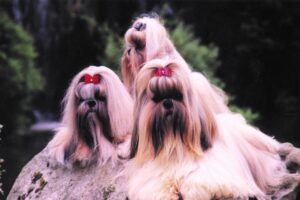
Explore the Shih Tzu’s history from ancient China to present, highlighting its evolution, breeding intricacies, and enduring charm.

Training the Performance Shih Tzu Dog – Shih Tzu are very much a thinking breed and will come up with different things to do if they are
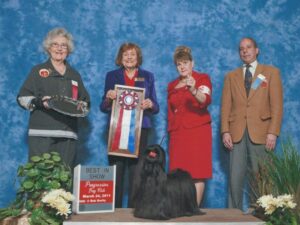
Sarah Lawrence is the breeder behind Chatterbox Toys Shih Tzu. Read about the kennel’s beginnings, the sires, the dams, the puppies & more!
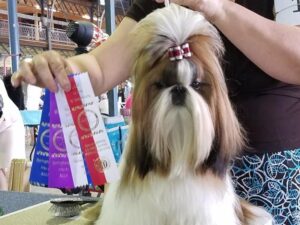
Carla Johnson is the breeder behind JOCAR Shih Tzu. Read about the kennel’s beginnings, champions, dogs, puppies, photos and more!

Barbara Brem is the breeder behind Palaquin Shih Tzu. Read about the kennel’s beginnings, dogs, puppies, photos and more!

Wendy Anderson is the breeder behind Winterholme Shih Tzu. Read about the kennel’s beginnings, champions, dogs, puppies, photos and more!
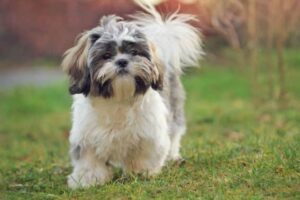
The Shih Tzu is a lively Toy dog with long flowing double coat. Read on to see what a correct Shih Tzu should look like to a seasoned judge.

Explore the Shih Tzu head’s history and standards, a breed trait facing loss, as described in a seminal 1972 article. Preservation is key.

Explore the Shih Tzu’s history from ancient China to present, highlighting its evolution, breeding intricacies, and enduring charm.

Training the Performance Shih Tzu Dog – Shih Tzu are very much a thinking breed and will come up with different things to do if they are

Sarah Lawrence is the breeder behind Chatterbox Toys Shih Tzu. Read about the kennel’s beginnings, the sires, the dams, the puppies & more!

Carla Johnson is the breeder behind JOCAR Shih Tzu. Read about the kennel’s beginnings, champions, dogs, puppies, photos and more!

Barbara Brem is the breeder behind Palaquin Shih Tzu. Read about the kennel’s beginnings, dogs, puppies, photos and more!

Wendy Anderson is the breeder behind Winterholme Shih Tzu. Read about the kennel’s beginnings, champions, dogs, puppies, photos and more!

The Shih Tzu is a lively Toy dog with long flowing double coat. Read on to see what a correct Shih Tzu should look like to a seasoned judge.
The best way to ensure a long and happy relationship with a purebred dog is to purchase one from a responsible breeder. Not sure where to begin?
Contact the National Parent Club’s Breeder Referral Program, which is listed on the AKC Breeder Referral Contacts page.
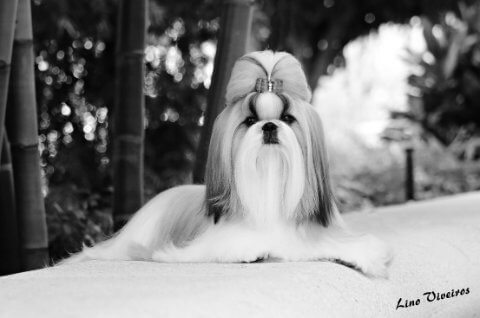

"*" indicates required fields
Showsight Magazine–the world’s most influential purebred dog publication since 1992. Each issue reaches a global audience dedicated to preserving the history and health of purpose bred dogs. Filled with award-winning editorial focused on news and insights from the dog show community, top breeders, handlers, AKC Judges, and more!